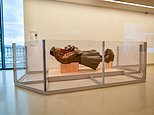Museum tour guide won’t speak about the battered statue of slave trader Edward Colston
Colston’s last resting place: Surrounded by old chocolate wrappers and steam engine parts, the battered statue torn down by BLM protesters now languishes in the scruffy store room of Bristol’s history museum
The battered statue of Edward Colston lies behind protective glass in a museumIt bears the red and blue graffiti from the Black Lives Matter protest in June 2020Visitors can see it still, but only by booking place one once-a-day behind-the-scenes tourOne tour guide has said ‘I’ve been given a long list of things I can and can’t say, I’m not going to say anything at all’
<!–
<!–
<!–<!–
<!–
(function (src, d, tag){
var s = d.createElement(tag), prev = d.getElementsByTagName(tag)[0];
s.src = src;
prev.parentNode.insertBefore(s, prev);
}(“https://www.dailymail.co.uk/static/gunther/1.17.0/async_bundle–.js”, document, “script”));
<!–
DM.loadCSS(“https://www.dailymail.co.uk/static/gunther/gunther-2159/video_bundle–.css”);
<!–
Still screened by protective glass, the battered statue of slave trader Edward Colston lies in a museum store room next to steam engine components, old chocolate wrappers and various other antiquities.
The bronze sculpture bears the red and blue graffiti from the Black Lives Matter protest in June 2020 when it was torn from its plinth in Bristol city centre, rolled through the streets and dumped in the harbour.
Museum visitors can view the statue, but only by booking a place on a once-a-day behind-the-scenes tour. Those hoping for commentary on the controversial effigy will be disappointed.
Still screened by protective glass, the battered statue of slave trader Edward Colston lies in a museum store room next to steam engine components, old chocolate wrappers and various other antiquities
The bronze sculpture bears the red and blue graffiti from the Black Lives Matter protest in June 2020 when it was torn from its plinth in Bristol city centre, rolled through the streets and dumped in the harbour
The volunteer guide who last week conducted a tour admitted: ‘I’ve been given a long list of things I can and can’t say, so I’m not going to say anything at all.’
Staff at the M Shed museum, which celebrates Bristol’s history, last week removed the statue from general view – a decision that, according to the museum, was in line with a visitor survey.
It was put in the store room of the adjoining L Shed just days before four activists seen on CCTV looping ropes around the monument and pulling it down were cleared by a jury of criminal damage.
Amid claims that the verdict had created a ‘vandals’ charter’, Attorney General Suella Braverman is considering referring the acquittal to the Court of Appeal.
The ‘Colston Four’ – Sage Willoughby, Rhian Graham, Milo Ponsford and Jake Skuse – are believed to have received legal aid to fund at least part of their defence.
A GoFundMe page for the ‘Bristol Topplers’ Defence Fund’ sought donations towards ‘legal fees not covered by legal aid’ and raised £13,500.
Museum visitors can view the statue, but only by booking a place on a once-a-day behind-the-scenes tour
Colston, a 17th Century merchant, made a fortune trading slaves but went on to donate so much money to philanthropic works in Bristol that his name appeared throughout the city on streets, schools and a concert hall.
The Government wants to increase the maximum sentence for damage to memorials or statues from three months to ten years, but experts fear it could lead to more acquittals.
Human rights barrister Adam Wagner said: ‘The changes are an open invitation to ten times more Colston-type trials.
‘All of the cases for damaging public monuments would be in front of a jury at Crown Court because the sentence would be raised to ten years so we will see a lot more of this.’
![]()


